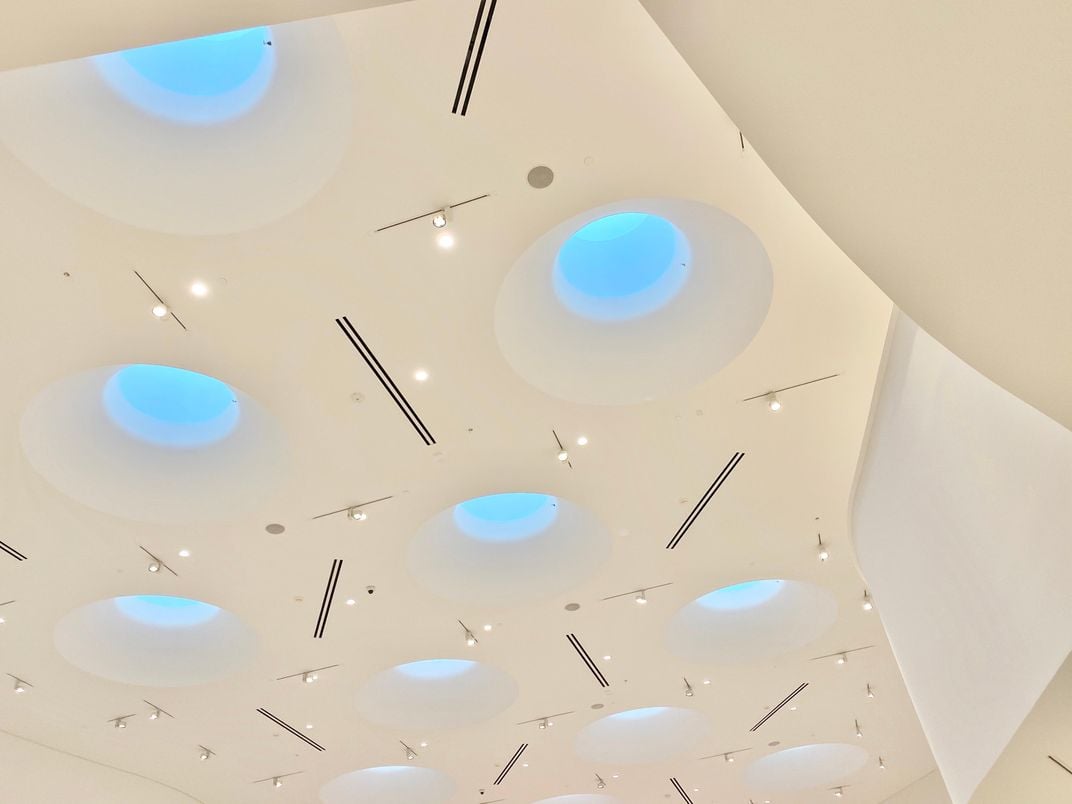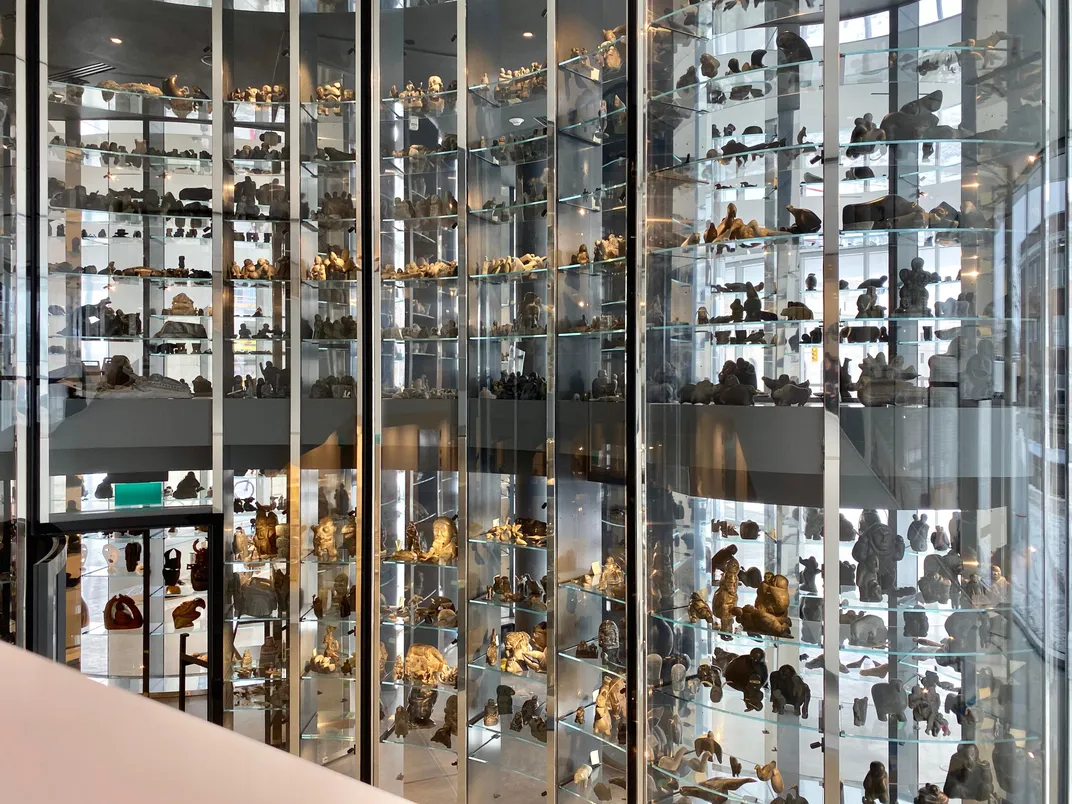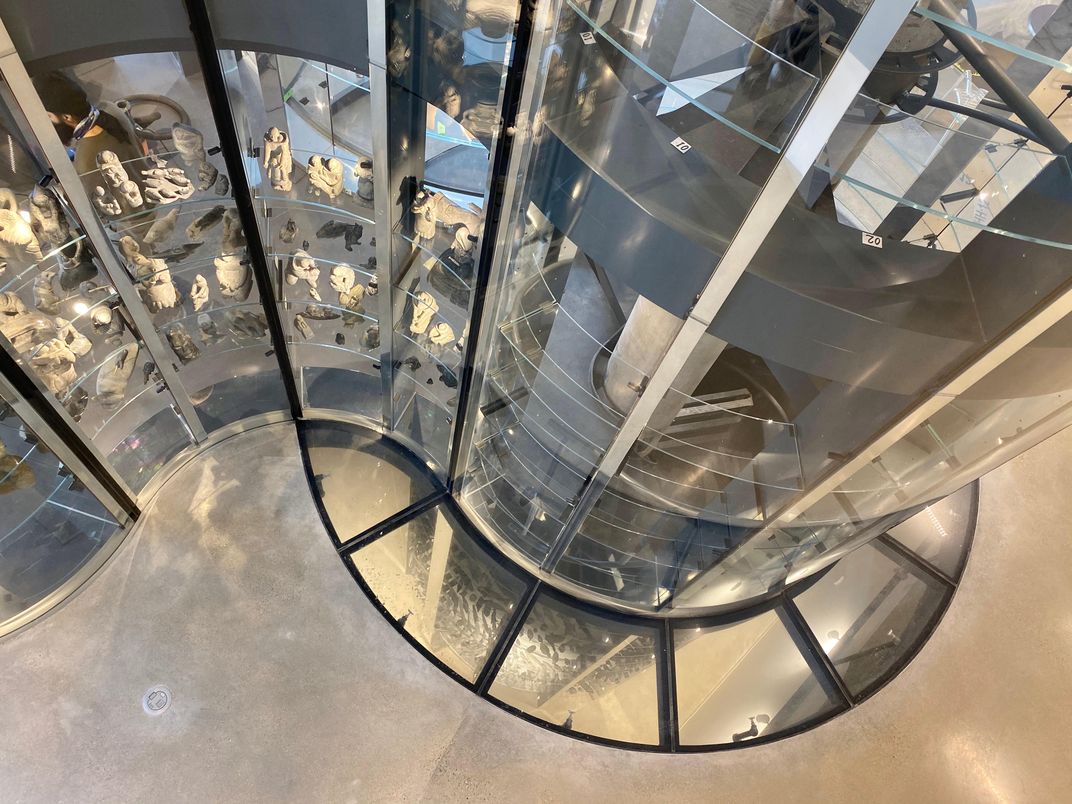Groundbreaking New Center Unveils World’s Largest Collection of Inuit Art
More than 20,000 works from artists across the Canadian Arctic are on display at Qaumajuq, a new museum-within-a-museum at the Winnipeg Art Gallery
/https://tf-cmsv2-smithsonianmag-media.s3.amazonaws.com/filer/41/5f/415fdb99-ab3d-4e18-bea8-6fb8af27385b/qaumajuq_michael_maltzan_architecture-main.jpg)
With curving contours of white Vermont granite, Qaumajuq, the new Inuit art center at the Winnipeg Art Gallery (WAG), is a stunning architectural presence in Manitoba’s capital city. Pronounced ‘KOW-ma-yourk’ (or HOW-ma-yourk, depending on the regional dialect of Inuktitut, the Inuit language), Qaumajuq houses 14,000 sculptures, prints, drawings and textile art created by Inuit artists from across the Canadian Arctic. In addition, nearly 7,400 artworks are on loan from the Government of Nunavut, awaiting the development of future museum facilities in the North. After more than a decade of planning, Qaumajuq, which opened in late March, brings the world’s largest public collection of Inuit art to view.
Following his selection as the building’s designer, Los Angeles-based architect Michael Maltzan and WAG Director and CEO Stephen Borys visited major museums in North America and Europe. In July 2013, accompanied by Inuit art curator Darlene Wight, associate architect George Cibinel and Dutch architectural photographer Iwan Baan, they traveled to the Nunavut communities of Iqaluit, Kinngait (formerly Cape Dorset) and Pangnirtung on the south coast of Baffin Island, where they toured art studios and ventured out into Cumberland Sound with Inuk outfitter Joavie Alivaktuk.
“It was the trip to the North, to the Arctic, that changed everything,” Borys recalls. “ Michael literally went back to the drawing board with his design, and while he was not replicating anything specifically, it was the combination of meeting the people, being in their homes, on their land, looking at light and texture, vistas and horizons. It all came together and truly inspired him.”
Reminiscent of sun-sculpted ice formations adrift in Cumberland Sound, Maltzan’s design calls to mind the momentous calving of glacial ice taking place in the polar regions in this troubling era of global warming. Qaumajuq, meaning “it is bright, it is lit,” chosen by Inuit language keepers, aptly describes the building’s gleaming exterior, the glass-fronted façade illuminating the entrance level and the 22 skylights that brighten the third-floor exhibit space. Named qilak (“sky”) in Inuktitut, the skylights remind elders of daylight coming through the top of the igloo while the soft night sky gives meaning to the traditional Inuit belief that stars are the lights of the qulliq (“lamp”) in the houses of ancestors long passed.

As the unanimous choice of the selection committee, Borys notes, “Michael pushed us to rethink what this center of Inuit art could be. Qaumajuq’s become much more than simply more exhibit or storage space—the center’s become a forum, a place for dialogue, for reconciliation, for research at the highest level, for public engagement. It’s a bit of the new museum model—the power of artwork to push conversations, to facilitate dialogue, and to be embedded in the K-12 school curriculum.”
Visitors to Qaumajuq are greeted by two major sculptures that animate the exterior plaza. The Inuit sea goddess, Sedna (Nuliajuk), forcefully rises from the stone of Tuniigusiia/The Gift. Created by third-generation female Inuit artist Goota Ashoona, the sculpture depicts a pair of throat-singers, an ancient vocal skill performed by Inuit women across the Arctic. Nearby the spirited rendering of a polar bear and cubs by Inuvialuit sculptor Abraham Anghik Ruben, entitled Time to Play, embodies those intimate moments of joy and patience that unite mothers and young, no matter their species.
Like the colossal forms of Arctic ice encountered by Inuit maritime hunters, Qaumajuq seems to float over the recessed glass façade fronting the street. It is connected on each floor to the Winnipeg Art Gallery, an imposing modernist triangular structure of fossil-embedded Manitoba limestone designed by Gustavo da Roza, which opened to the public in 1971. Qaumajuq serves as the consummate jubilee gift, celebrating the gallery’s steadfast dedication in exhibiting, publishing and preserving the work of Inuit artists for over 50 years.
The WAG’s commitment to Inuit art is intimately linked to the city’s historical status as a trading post of the Hudson’s Bay Company (HBC) whose fur traders (factors) spread out over the prairies and northland, actively trading with Indigenous families across the country. Later, Winnipeg served as the administrative center for the HBC’s Arctic operations. Carvings by Inuit artists were shipped from northern posts in the late 1950s, capturing the passionate interest and enduring support of Winnipeg collectors, including WAG director, Ferdinand Eckhardt; artist and art historian George Swinton; botanist Jerry Twomey; and gallery owner Faye Settler. The remarkable early collections of Swinton and Twomey form the bedrock of the WAG holdings. As the first curator of Inuit art, Jean Blodgett developed an international reputation for the gallery’s Inuit art collection, producing thematic, community, and solo exhibitions with a library of catalogue publications. Over the past 35 years, Darlene Wight has curated more than 95 exhibitions with many significant publications. In 2013, Wight received an honorary doctorate from the University of Manitoba in recognition of her exceptional contribution in presenting and further developing the gallery’s Inuit art collection.
Despite a vigorous exhibition program, much of the art work in the WAG collection remained in storage, inaccessible to visitors. In a recent interview, Igloolik filmmaker Zacharias Kunuk recalled a time when curators at the WAG took him to the basement to see the collection of Inuit sculpture. “Drawers and drawers of artifacts,” he said. “There are so many Inuit artifacts down South—and they’re finally getting seen!”

Today, a soaring two-story glass-enclosed Visible Vault (with a third level below for curatorial access) presents over 4,500 stone sculptures from 34 communities across the Canadian Arctic. Impressive stone and ceramic sculptures by artists from Kinngait, Inukjuak, Puvirnituq, Baker Lake (Qamanittuaq), Rankin Inlet, Naujaat, Sanikiluaq, and other communities are displayed on glass shelves within the vault. The serpentine vault provides a winding path reminiscent of a hunter’s trail, passing through the far-flung settlements of the Canadian Arctic, enriched by images of Arctic wildlife, hunting encounters, scenes of family life, and the mystic experiences of shamans envisioned by three generations of Inuit sculptors.
The spacious exhibit gallery above—almost 8,000 square feet—forms a vital counterpart to the glass-enclosed vault. The inaugural exhibition, running through December 2021, is entitled “INUA” (meaning “spirit” or “life force”) and provides a fitting acronym: Inuit Nunangat Ungammuaktut Atautikkut, meaning “Inuit Moving Forward Together.” The talented team of Inuit curators—Heather Igloliorte, Krista Ulujuk Zawadski, Asinnajaq and Kablusiak—bring together established and emerging artists from Inuit Nunangat, the homeland of Inuit in Canada, and other parts of Canada, Greenland and Alaska whose works engage critical themes of identity, language, environment, colonial history, and personal and social well-being.
“We were thinking about regional representation and gender parity and really focused on trying to bring in LGBTQ artists,” Igloliorte says. “We were also interested in inviting artists who were working in one medium to try something new and explore another medium.”
The curatorial team also used everyday architecture that one would encounter in the North to organize the exhibition. Within the reconstructed walls of his own hunting cabin, Igloolik filmmaker Zacharias Kunuk presents a powerful video projected on the four cabin walls surrounding the viewer contrasting Inuit life in Igloolik and the critical dependence on water, land and animals against the contentious demands of corporate mining concerns, threatening the land and wildlife with often toxic consequences. A metal shipping container—a common sight in the North where remote coastal communities are supplied by an annual barge—houses a multi-media installation by Nunatsiavut artist Glenn Gear exploring the mythology of the Northern Lights. Recreating a full-size domestic interior reminiscent of the 1950s, film artist Lindsay McIntyre recalls the memory of her uncle, political activist Kiviaq, the first Inuk lawyer. An empty lounge chair imparts a conflated sense of presence and absence while evoking a mood of isolation and loss against the chatter of radio and television broadcasts. Video profiles of several artists in the “INUA” exhibition can be accessed online.
Two riveting images in the exhibit are a display of polar bear finger bones in Maureen Gruben’s Waiting for the Shaman recalling the powerful tradition of Inuit amulets, and a self-portrait by sculptor Bill Nasogaluak inscribed with his personal government-issued identification number, assigned to Inuit men, women and children across the eastern and western regions of the Canadian Arctic during the 1950s and ‘60s. The bureaucratic loss of one’s personal name remains a palpable emotional experience for Nasogaluak and others across the North.
Several artists’ works transform the use of Inuit clothing art and materials in novel, provocative ways. A full-size spacesuit made of sealskin by Jesse Tungilik (a collaborative work with Inuit students) bears beaded arm patches of the Nunavut flag and NASA written in Inuktitut syllabics, recalling the bemused comment by artist Pitseolak Ashoona at the first moon landing, “our shamans often visited the moon.” A three-piece narrative mural featuring sealskin lettering by Siku Alloloo, the elegantly designed woman’s sealskin dress by Beatrice Deer and Julie Grenier, and another garment by Maata Kyak pose an artful challenge to the international boycott of sealskin products that has long constrained a vital segment of the northern economy.
As sculptor Abraham Anghik Ruben has written, “With the new Inuit art centre, the issues confronting today’s Inuit must be an integral part of the conversation. The concerns of Inuit artists must be heard in concert with issues of culture, language survival, climate change, food security, geo-political awareness, and other pressing issues. Artists of the circumpolar world should use their voices to bring focus and amplification to these concerns.”

Although expanded exhibit and storage space prompted the initial idea for a center of Inuit art, Borys remains keenly aware of its significance in light of Canada’s Truth and Reconciliation Commission, whose 2015 report with 94 calls to action awakened Canadians to the personal pain, loss of language, and cultural trauma suffered by generations of indigenous students through the residential school system. The Winnipeg Art Gallery is located on Treaty No. 1, the original lands of Anishinaabe, Ininiwak, Anishininiwak, Dakota and Dene peoples, and on the homeland of the Métis Nation.
“I find this project has helped me and our team to look at ways that we can further indigenize our programs—to look at decolonization and to make inroads with the First Nations and Metis communities in terms of protocol and how we work,” says Borys. “The Inuit Art Center—Qaumajuq—has actually helped us to move forward in terms of relevant program development and how we want to stay meaningful in the community.”
A masterful architectural statement, Qaumajuq joins a preeminent corps of bold museum design providing access to the art and culture of Indigenous communities, notably the Museum of Anthropology, University of British Columbia, designed by Arthur Erickson; the Canadian Museum of History created by Blackfoot architect, Douglas Cardinal; and the Smithsonian’s National Museum of the American Indian, also conceived by Cardinal.
“I’m excited for people to see all the different kinds of diverse work and to appreciate this time for Inuit art,” says “INUA” co-curator Igloliorte. “We’ve got this building now—it’s really incredible—and I hope that artists are really inspired and say, ‘I want to make work there. I want to show there.’”
In the Inuit language, Qaumajuq builds on the stem ‘qau’ meaning light—the light of dawn as well as the enlightenment of knowledge (qaujimaniq). Qaumajuq signals the light of a new day, recognizing the breadth of knowledge, pragmatic experience and artistic skill of Inuit society—and, by extension, inspiring a deeper appreciation for the rich intellectual cultures of Indigenous societies throughout North America and beyond.
Planning Your Next Trip?
Explore great travel deals
Smithsonian magazine participates in affiliate link advertising programs. If you purchase an item through these links, we receive a commission.
/https://tf-cmsv2-smithsonianmag-media.s3.amazonaws.com/accounts/headshot/Bernedette_Driscoll_Engelstad.jpg)


/https://tf-cmsv2-smithsonianmag-media.s3.amazonaws.com/accounts/headshot/Bernedette_Driscoll_Engelstad.jpg)